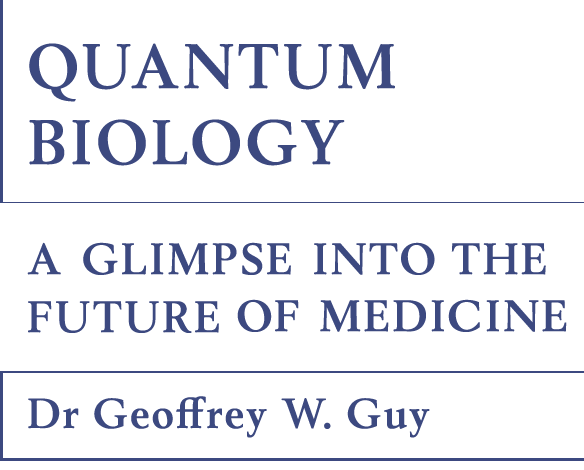
- About Geoffrey Guy
- List of chapters
- 1 Flatworms and xenobots
- 2 Beyond neurons: quantum effects in the brain
- 3 The ghost in the machine
- 4 Inflammation and equilibrium
- 5 The light fantastic
- 6 Lessons from the pandemic
- 7 Reassessing the causes of cancer
- 8 Energy, information and light
- 9 Before the origins of life
- 10 Unravelling the double helix
- 11 The computer in our cells
- 12 Space: the quantum frontier?
- 13 The quantum fractal
- 14 The path to mainstream
- Glossary
- Buy the book



4
Inflammation and equilibrium
This page provides online resources relating to Chapter 1 of Quantum Biology: A Glimpse into the Future of Medicine. Read a chapter extract, or scroll down to access figures and terminology, additional resources published by The Guy Foundation, and a list of further reading.
Name of the Chapter
Subheading
Inflammation matters a great deal in modern medicine. We know that it lies behind a very wide range of conditions: osteoarthritis, psoriasis, Crohn’s disease, asthma, diabetes and metabolic syndrome are all associated with chronic inflammation; we also suspect it is implicated in neurodegenerative diseases such as Parkinson’s, multiple sclerosis and Alzheimer’s, as well as in some infections such as sepsis. All the chronic inflammatory diseases are also linked to the production of what we’ve been calling ‘surplus oxygen’ (which can be damaging to various parts of our bodies), long before they become clinically apparent.
We are looking to see whether quantum effects may be involved in inflammation and in the production and management of surplus oxygen, two processes which are very much connected. If, as we believe, quantum effects are present, this has important implications for the ways in which we treat the diseases and conditions I mentioned above.
Buy the book here
A dissipative system is one that is open and not in a state of equilibrium. It exchanges energy, matter and information with its environment. Hurricanes and human society are both dissipative systems.
We contend that life itself is also a dissipative system.
It is worth noting that the physicist Matthew Fisher has suggested that quantum effects (specifically entangled nuclear spin) could modulate the ratio of free to bound calcium ions.
His theory relates to nerves and the brain, but it could potentially apply to all cellular calcium.
Redox is a chemical reaction in which the oxidation states of atoms are changed by the transfer of electrons. Usually, the reducing agent undergoing oxidation loses electrons, while the oxidising agent undergoing reduction gains electrons.
Reactive oxygen species (ROS) are highly reactive chemicals formed from oxygen atoms during the process of breathing. They include superoxide anion, hydrogen peroxide (H2O2) and hydroxyl radical. ROS play a role in signalling between cells and also in maintaining homeostasis.
However, they can also cause irreversible damage to DNA, as they prevent some cells from performing their original functions.
The body also generates reactive nitrogen species (RNS), which can contribute to harmful circulatory conditions.
An ROS scavenger removes ROS and protects cells from the inflammation caused by oxidative stress. ROS scavengers are composed of naturally occurring polymers – substances with very large molecules which are built up from many identical subunits.
2022 Autumn Series
Quantum mitochondria: energy, information and implications for health and disease
Videos

The Guy Foundation 2024 Spring Series
Quantum and thermodynamic perspectives on ageing, and 2024 Spring Series summary
Professor Alistair Nunn, The Guy Foundation and University of Westminster

The Guy Foundation 2022 Spring Series
Natural products as redox modulators and the therapeutic perspective
Professor Alistair Nunn, University of Westminster and The Guy Foundation
Dr Wolfgang Brysch, MetrioPharm AG
Betony Adams, Ilya Sinayskiy and Francesco Petruccione, ‘An open quantum system approach to the radical pair mechanism’, Scientific Reports 8 (2018), doi.org/10.1038/s41598-018-34007-4
An I. Jonckheere, Jan A. M. Smeitink and Richard J. T. Rodenburg, ‘Mitochondrial ATP synthase: architecture, function and pathology’, Journal of Inherited Metabolic Disease 35:2 (2012), doi.org/10.1007/s10545-011-9382-9
James L. Martin, Robert Ishmukhametov, Tassilo Hornung and Wayne D. Frasch, ‘Anatomy of F1-ATPase powered rotation’, PNAS 111:10 (2014), doi.org/10.1073/pnas.1317784111
Sara Schumann, Astrid Kaiser, Ferdinando Nicoletti et al., ‘Immune-modulating drug MP1032 with SARS-CoV-2 antiviral activity in vitro: a potential multi-target approach for prevention and early intervention treatment of COVID-19’, International Journal of Molecular Sciences 21:22 (2020), doi.org/10.3390/ijms21228803
Hazel J. Shields, Annika Traa and Jeremy M. Van Raamsdonk, ‘Beneficial and detrimental effects of reactive oxygen species on lifespan: a comprehensive review of comparative and experimental studies’, Frontiers in Cell and Developmental Biology 9 (2021), doi.org/10.3389/fcell.2021.628157
